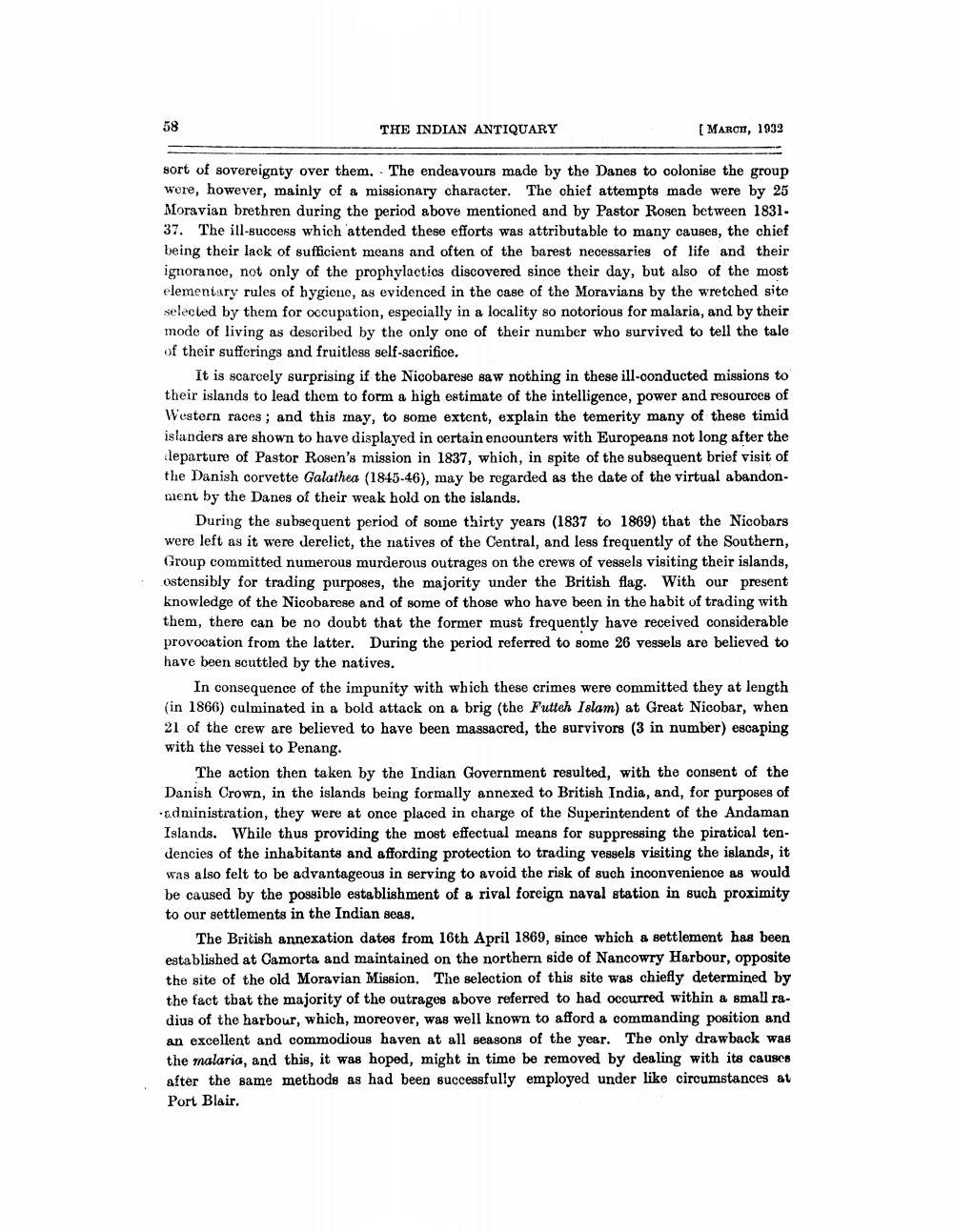________________
THE INDIAN ANTIQUARY
[MARCH, 1932
sort of sovereignty over them. The endeavours made by the Danes to colonise the group were, however, mainly of a missionary character. The chief attempts made were by 25 Moravian brethren during the period above mentioned and by Pastor Rosen between 1831. 37. The ill-success which attended these efforts was attributable to many causes, the chief being their lack of sufficient means and often of the barest necessaries of life and their ignorance, not only of the prophylactics discovered since their day, but also of the most elementary rules of hygiene, as evidenced in the case of the Moravians by the wretched site selected by them for occupation, especially in a locality so notorious for malaria, and by their mode of living as described by the only one of their number who survived to tell the tale of their sufferings and fruitless self-sacrifice.
It is scarcely surprising if the Nicobarese saw nothing in these ill-conducted missions to their islands to lead them to form a high estimate of the intelligence, power and resources of Western races; and this may, to some extent, explain the temerity many of these timid islanders are shown to have displayed in certain encounters with Europeans not long after the
leparture of Pastor Rosen's mission in 1837, which, in spite of the subsequent brief visit of the Danish corvette Galathea (1845-46), may be regarded as the date of the virtual abandonment by the Danes of their weak hold on the islands.
During the subsequent period of some thirty years (1837 to 1869) that the Nicobars were left as it were derelict, the natives of the Central, and less frequently of the Southern, Group committed numerous murderous outrages on the crews of vessels visiting their islands, ostensibly for trading purposes, the majority under the British flag. With our present knowledge of the Nicobarese and of some of those who have been in the habit of trading with them, there can be no doubt that the former must frequently have received considerable provocation from the latter. During the period referred to some 26 vessels are believed to have been scuttled by the natives.
In consequence of the impunity with which these crimes were committed they at length (in 1866) culminated in a bold attack on a brig (the Futteh Islam) at Great Nicobar, when 21 of the crew are believed to have been massacred, the survivors (3 in number) escaping with the vessel to Penang.
The action then taken by the Indian Government resulted, with the consent of the Danish Crown, in the islands being formally annexed to British India, and, for purposes of -administration, they were at once placed in charge of the Superintendent of the Andaman Islands. While thus providing the most effectual means for suppressing the piratical tendencies of the inhabitants and affording protection to trading vessels visiting the islands, it was also felt to be advantageous in serving to avoid the risk of such inconvenience as would be caused by the possible establishment of a rival foreign naval station in such proximity to our settlements in the Indian seas.
The British annexation dates from 16th April 1869, since which a settlement has been established at Camorta and maintained on the northern side of Nancowry Harbour, opposite the site of the old Moravian Mission. The selection of this site was chiefly determined by the fact that the majority of the outrages above referred to had occurred within a small radius of the harbour, which, moreover, was well known to afford a commanding position and an excellent and commodious haven at all seasons of the year. The only drawback was the malaria, and this, it was hoped, might in time be removed by dealing with its causes after the same methode as had been successfully employed under like circumstances at Port Blair.




